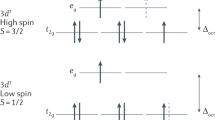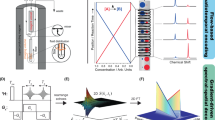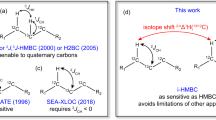Abstract
The instrumental analysis of reaction mixtures is usually the rate-determining step in the optimization of chemical processes. Traditionally, reactions are analyzed by gas chromatography, HPLC or quantitative NMR spectroscopy on high-field spectrometers. However, chromatographic methods require elaborate work-up and calibration protocols, and high-field NMR spectrometers are expensive to purchase and operate. This protocol describes an inexpensive and highly effective analysis method based on low-field benchtop NMR spectroscopy. Its key feature is the use of fluorine-labeled model substrates that, because of the wide chemical shift range and high sensitivity of 19F, enable separate, quantitative detection of product and by-product signals even on low-field, permanent magnet spectrometers. An external lock/shim device obviates the need for deuterated solvents, permitting the direct, noninvasive measurement of crude reaction mixtures with minimal workup. The low field-strength facilitates a homogeneous excitation over a wide chemical shift range, minimizing systematic integration errors. The addition of the optimal amount of the nonshifting relaxation agent tris(acetylacetonato) iron(III) minimizes relaxation delays at full resolution, reducing the analysis time to 32 s per sample. The correct choice of processing parameters is also crucial. A step-by-step guideline is provided, the influence of all parameters, including adjustments needed when using high-field spectrometers, is discussed and potential pitfalls are highlighted. The wide applicability of the analytical protocol for reaction optimization is illustrated by three examples: a Buchwald-Hartwig amination, a Suzuki coupling and a C–H arylation reaction.
Key points
-
Discovery and optimization of chemical transformations involve screening numerous reaction parameters. Quantification of all reaction constituents is often the bottleneck in this process.
-
For most reactions, there are suitable fluorinated model substrates enabling analysis by 19F NMR spectroscopy. Inexpensive and maintenance-free benchtop NMR spectrometers are optimal for 19F NMR analysis because of the wide excitation profile. In the presence of Fe(acac)3, quantitative results can be obtained in <1 min per sample.
This is a preview of subscription content, access via your institution
Access options
Access Nature and 54 other Nature Portfolio journals
Get Nature+, our best-value online-access subscription
$29.99 / 30 days
cancel any time
Subscribe to this journal
Receive 12 print issues and online access
$259.00 per year
only $21.58 per issue
Buy this article
- Purchase on Springer Link
- Instant access to full article PDF
Prices may be subject to local taxes which are calculated during checkout













Similar content being viewed by others
Data availability
The data supporting the findings of this study are available within the article, its Supplementary Information and its Source Data files, as well as the primary supporting research papers25,26,27,28,29,30,31. Electronic NMR spectral data are available in a repository (https://sciflection.com/96fadf14-bd22-4322-8650-8e034f76b978). Source data are provided with this paper.
Change history
05 March 2024
A Correction to this paper has been published: https://doi.org/10.1038/s41596-024-00982-4
References
Carlson, R. & Carlson, J. Design and Optimization in Organic Synthesis Vol. 24 (Elsevier, 1992).
Markert, C., Rösel, P. & Pfaltz, A. Combinatorial ligand development based on mass spectrometric screening and a double mass-labeling strategy. J. Am. Chem. Soc. 130, 3234–3235 (2008).
McNally, A., Prier, C. K. & MacMillan, D. W. C. Discovery of an α-amino C–H arylation reaction using the strategy of accelerated serendipity. Science 334, 1114–1117 (2011).
Robbins, D. W. & Hartwig, J. F. A simple, multidimensional approach to high-throughput discovery of catalytic reactions. Science 333, 1423–1427 (2011).
Hopkinson, M. N., Gómez-Suárez, A., Teders, M., Sahoo, B. & Glorius, F. Accelerated discovery in photocatalysis using a mechanism-based screening method. Angew. Chem. Int. Ed. 55, 4361–4366 (2016).
Troshin, K. & Hartwig, J. F. Snap deconvolution: an informatics approach to high-throughput discovery of catalytic reactions. Science 357, 175–181 (2017).
Collins, K. D. & Glorius, F. A robustness screen for the rapid assessment of chemical reactions. Nat. Chem. 5, 597–601 (2013).
Prieto Kullmer, C. N. et al. Accelerating reaction generality and mechanistic insight through additive mapping. Science 376, 532–539 (2022).
Pitzer, L., Schäfers, F. & Glorius, F. Rapid assessment of the reaction-condition-based sensitivity of chemical transformations. Angew. Chem. Int. Ed. 58, 8572–8576 (2019).
Schafer, W., Bu, X., Gong, X., Joyce, L. A. & Welch, C. J. High-throughput analysis for high-throughput experimentation in organic chemistry. In Comprehensive Organic Synthesis Edn. 2 (ed. Knochel, P.) 28–53 (Elsevier, 2014).
de Vries, A. H. & de Vries, J. G. The power of high-throughput experimentation in homogeneous catalysis research for fine chemicals. Eur. J. Org. Chem. 2003, 799–811 (2003).
Krska, S. W., DiRocco, D. A., Dreher, S. D. & Shevlin, M. The evolution of chemical high-throughput experimentation to address challenging problems in pharmaceutical synthesis. Acc. Chem. Res. 50, 2976–2985 (2017).
Mennen, S. M. et al. The evolution of high-throughput experimentation in pharmaceutical development and perspectives on the future. Org. Process Res. Dev. 23, 1213–1242 (2019).
Isbrandt, E. S., Sullivan, R. J. & Newman, S. G. High throughput strategies for the discovery and optimization of catalytic reactions. Angew. Chem. Int. Ed. 58, 7180–7191 (2019).
Buitrago Santanilla, A. et al. Nanomole-scale high-throughput chemistry for the synthesis of complex molecules. Science 347, 49–53 (2015).
Welch, C. J. High throughput analysis enables high throughput experimentation in pharmaceutical process research. React. Chem. Eng. 4, 1895–1911 (2019).
Welch, C. J. et al. MISER chromatography (multiple injections in a single experimental run): the chromatogram is the graph. Tetrahedron Asymmetry 21, 1674–1681 (2010).
Holzgrabe, U. Quantitative NMR spectroscopy in pharmaceutical applications. Prog. Nucl. Magn. Reson. Spectrosc. 57, 229–240 (2010).
Marquez, B. L. & Williamson, R. T. Quantitative applications of NMR spectroscopy. In Chemical Engineering in the Pharmaceutical Industry 133–149 (John Wiley & Sons, Ltd, 2019).
Diehl, B., Holzgrabe, U., Monakhova, Y. & Schönberger, T. Quo vadis qNMR? J. Pharm. Biomed. Anal. 177, 112847 (2020).
Mitchell, J., Gladden, L. F., Chandrasekera, T. C. & Fordham, E. J. Low-field permanent magnets for industrial process and quality control. Prog. Nucl. Magn. Reson. Spectrosc. 76, 1–60 (2014).
Danieli, E., Perlo, J., Blümich, B. & Casanova, F. Small magnets for portable NMR spectrometers. Angew. Chem. Int. Ed. 49, 4133–4135 (2010).
Dalitz, F., Cudaj, M., Maiwald, M. & Guthausen, G. Process and reaction monitoring by low-field NMR spectroscopy. Prog. Nucl. Magn. Reson. Spectrosc. 60, 52–70 (2012).
Dyga, M., Oppel, C. & Gooßen, L. J. RotoMate: An open-source, 3D printed autosampler for use with benchtop nuclear magnetic resonance spectrometers. HardwareX 10, e00211 (2021).
Matheis, C., Jouvin, K. & Goossen, L. J. Sandmeyer difluoromethylation of (hetero-)arenediazonium Salts. Org. Lett. 16, 5984–5987 (2014).
Danoun, G. et al. Sandmeyer trifluoromethylation. Synthesis 46, 2283–2286 (2014).
Bertoli, G., Exner, B., Evers, M. V., Tschulik, K. & Gooßen, L. J. Metal-free trifluoromethylthiolation of arenediazonium salts with Me4NSCF3. J. Fluor. Chem. 210, 132–136 (2018).
Ou, Y. & Gooßen, L. J. Copper-mediated synthesis of (diethylphosphono)difluoromethyl thioethers from diazonium salts, NaSCN, and TMS-CF2PO(OEt)2. Asian J. Org. Chem. 8, 650–653 (2019).
Weber, P. et al. A highly active ylide-functionalized phosphine for palladium-catalyzed aminations of aryl chlorides. Angew. Chem. Int. Ed. 58, 3203–3207 (2019).
Sivendran, N. et al. Photochemical Sandmeyer-type halogenation of arenediazonium salts. Chem. Eur. J. 28, e202103669 (2022).
Bertoli, G. et al. C−H fluoromethoxylation of arenes by photoredox catalysis. Angew. Chem. Int. Ed. 62, e202215920 (2023).
Holzgrabe, U. Quantitative NMR spectroscopy in pharmaceutical R&D. In eMagRes 45–56 (John Wiley & Sons, Ltd., 2015).
Schoenberger, T. ENFSI Guideline for qNMR Analysis. Available at https://enfsi.eu/wp-content/uploads/2017/06/qNMR-Guideline_version001.pdf (2019).
International Organization for Standardization. ISO 24583:2022 Available at https://www.iso.org/standard/78997.html (2022).
Silva Elipe, M. V. & Milburn, R. R. Monitoring chemical reactions by low-field benchtop NMR at 45 MHz: pros and cons. Magn. Reson. Chem. 54, 437–443 (2016).
Dolbier, W. R. Jr. Guide to Fluorine NMR for Organic Chemists (John Wiley & Sons, Ltd., 2016).
Wang, X., Patil, S. M., Keire, D. A., Xu, X. & Chen, K. Application of ultra-centrifugation and bench-top 19F NMR for measuring drug phase partitioning for the ophthalmic oil-in-water emulsion products. AAPS PharmSciTech 19, 1647–1651 (2018).
Howe, P. W. A. Recent developments in the use of fluorine NMR in synthesis and characterisation. Prog. Nucl. Magn. Reson. Spectrosc. 118–119, 1–9 (2020).
O’Hagan, D. Understanding organofluorine chemistry. An introduction to the C–F bond. Chem. Soc. Rev. 37, 308–319 (2008).
Mattes, A. O. et al. Application of 19F quantitative NMR to pharmaceutical analysis. Concepts Magn. Reson. Part A 45A, e21422 (2016).
Purser, S., Moore, P. R., Swallow, S. & Gouverneur, V. Fluorine in medicinal chemistry. Chem. Soc. Rev. 37, 320–330 (2008).
Inoue, M., Sumii, Y. & Shibata, N. Contribution of organofluorine compounds to pharmaceuticals. ACS Omega 5, 10633–10640 (2020).
Campbell, M. G. & Ritter, T. Modern carbon–fluorine bond forming reactions for aryl fluoride synthesis. Chem. Rev. 115, 612–633 (2015).
Champagne, P. A., Desroches, J., Hamel, J.-D., Vandamme, M. & Paquin, J.-F. Monofluorination of organic compounds: 10 years of innovation. Chem. Rev. 115, 9073–9174 (2015).
Landelle, G., Bergeron, M., Turcotte-Savard, M.-O. & Paquin, J.-F. Synthetic approaches to monofluoroalkenes. Chem. Soc. Rev. 40, 2867–2908 (2011).
Umemoto, T. et al. Power- and structure-variable fluorinating agents. The N-fluoropyridinium salt system. J. Am. Chem. Soc. 112, 8563–8575 (1990).
Watson, D. A. et al. Formation of ArF from LPdAr(F): catalytic conversion of aryl triflates to aryl fluorides. Science 325, 1661–1664 (2009).
Fier, P. S. & Hartwig, J. F. Selective C-H fluorination of pyridines and diazines inspired by a classic amination reaction. Science 342, 956–960 (2013).
Molnár, I. G. & Gilmour, R. Catalytic difluorination of olefins. J. Am. Chem. Soc. 138, 5004–5007 (2016).
Prakash, G. K. S. & Yudin, A. K. Perfluoroalkylation with organosilicon reagents. Chem. Rev. 97, 757–786 (1997).
Tomashenko, O. A. & Grushin, V. V. Aromatic trifluoromethylation with metal complexes. Chem. Rev. 111, 4475–4521 (2011).
Cho, E. J. et al. The palladium-catalyzed trifluoromethylation of aryl chlorides. Science 328, 1679–1681 (2010).
Charpentier, J., Früh, N. & Togni, A. Electrophilic trifluoromethylation by use of hypervalent iodine reagents. Chem. Rev. 115, 650–682 (2015).
Umemoto, T. & Ishihara, S. Power-variable electrophilic trifluoromethylating agents. S-, Se-, and Te-(trifluoromethyl)dibenzothio-, -seleno-, and -tellurophenium salt system. J. Am. Chem. Soc. 115, 2156–2164 (1993).
Hafner, A. & Bräse, S. Ortho-trifluoromethylation of functionalized aromatic triazenes. Angew. Chem. Int. Ed. 51, 3713–3715 (2012).
Le, C., Chen, T. Q., Liang, T., Zhang, P. & MacMillan, D. W. C. A radical approach to the copper oxidative addition problem: trifluoromethylation of bromoarenes. Science 360, 1010–1014 (2018).
Britton, R. et al. Contemporary synthetic strategies in organofluorine chemistry. Nat. Rev. Methods Prim. 1, 1–22 (2021).
Wiesenfeldt, M. P., Nairoukh, Z., Li, W. & Glorius, F. Hydrogenation of fluoroarenes: direct access to all-cis-(multi)fluorinated cycloalkanes. Science 357, 908–912 (2017).
Chen, K., Berg, N., Gschwind, R. & König, B. Selective single C(sp3)–F bond cleavage in trifluoromethylarenes: merging visible-light catalysis with Lewis acid activation. J. Am. Chem. Soc. 139, 18444–18447 (2017).
Dolbier, W. R. Fluorine chemistry at the millennium. J. Fluor. Chem. 126, 157–163 (2005).
Wiesenfeldt, M. P. et al. General access to cubanes as benzene bioisosteres. Nature 618, 513–518 (2023).
Power, J. E. et al. Increasing the quantitative bandwidth of NMR measurements. Chem. Commun. 52, 2916–2919 (2016).
Yamazaki, T., Saito, T. & Ihara, T. A new approach for accurate quantitative determination using fluorine nuclear magnetic resonance spectroscopy. J. Chem. Metrol. 11, 16–22 (2017).
Jacobsen, N. E. NMR Spectroscopy Explained: Simplified Theory, Applications and Examples for Organic Chemistry and Structural Biology (Wiley, 2007).
Ellis, D. A., Martin, J. W., Muir, D. C. G. & Mabury, S. A. Development of an 19F NMR method for the analysis of fluorinated acids in environmental water samples. Anal. Chem. 72, 726–731 (2000).
Schoenberger, T., Monakhova, Y. B., Lachenmeier, D. W. & Kuballa, T. Guide to NMR Method Development and Validation – Part I: Identification and Quantification Available at https://eurolab-d.de/files/guide_to_nmr_method_development_and_validation_-_part_i_identification_and_quantification_may_2014.pdf (2014).
Bloembergen, N., Purcell, E. M. & Pound, R. V. Relaxation effects in nuclear magnetic resonance absorption. Phys. Rev. 73, 679–712 (1948).
Callaghan, P. T. Principles of Nuclear Magnetic Resonance Microscopy (Clarendon Press, 1993).
Bloch, F. Nuclear induction. Phys. Rev. 70, 460–474 (1946).
Bloembergen, N., Purcell, E. M. & Pound, R. V. Nuclear magnetic relaxation. Nature 160, 475–476 (1947).
Levy, G. C. & Komoroski, R. A. Paramagnetic relaxation reagents. Alternatives or complements to lanthanide shift reagents in nuclear magnetic resonance spectral analysis. J. Am. Chem. Soc. 96, 678–681 (1974).
Bara-Estaún, A. et al. Paramagnetic relaxation agents for enhancing temporal resolution and sensitivity in multinuclear FlowNMR spectroscopy. Chem. Eur. J. 29, e202300215 (2023).
Kocman, V., Di Mauro, G. M., Veglia, G. & Ramamoorthy, A. Use of paramagnetic systems to speed-up NMR data acquisition and for structural and dynamic studies. Solid State Nucl. Magn. Reson. 102, 36–46 (2019).
Mortimer, R. D. & Dawson, B. A. Using fluorine-19 NMR for trace analysis of fluorinated pesticides in food products. J. Agric. Food Chem. 39, 1781–1785 (1991).
Mestrelab Research. MestreNova Manual. Available at https://mnova.pl/files/download/MestReNova-12-0-0_Manual.pdf (2017).
Claridge, T. D. W. Chapter 2 – Introducing high-resolution NMR. In High-Resolution NMR Techniques in Organic Chemistry Edn. 3 (ed. Claridge, T. D. W.) 11–59 (Elsevier, 2016)
Ernst, R. R. Sensitivity enhancement in magnetic resonance. In Advances in Magnetic and Optical Resonance Vol. 2 1–135 (Elsevier, 1966).
Rosenau, C. P., Jelier, B. J., Gossert, A. D. & Togni, A. Exposing the origins of irreproducibility in fluorine NMR spectroscopy. Angew. Chem. Int. Ed. 57, 9528–9533 (2018).
Guide to NMR method development and validation – part 1: identification and quantification. In Handbook of Transnational Economic Governance Regimes 1041–1053 (Brill | Nijhoff, 2010).
Clarke, C. J., Tu, W.-C., Levers, O., Bröhl, A. & Hallett, J. P. Green and sustainable solvents in chemical processes. Chem. Rev. 118, 747–800 (2018).
Hartwig, J. F. Evolution of a fourth generation catalyst for the amination and thioetherification of aryl halides. Acc. Chem. Res. 41, 1534–1544 (2008).
Ruiz-Castillo, P. & Buchwald, S. L. Applications of palladium-catalyzed C–N cross-coupling reactions. Chem. Rev. 116, 12564–12649 (2016).
Biafora, A., Krause, T., Hackenberger, D., Belitz, F. & Gooßen, L. J. ortho-C−H arylation of benzoic acids with aryl bromides and chlorides catalyzed by ruthenium. Angew. Chem. Int. Ed. 55, 14752–14755 (2016).
Altman, R. A., Fors, B. P. & Buchwald, S. L. Pd-catalyzed amination reactions of aryl halides using bulky biarylmonophosphine ligands. Nat. Protoc. 2, 2881–2887 (2007).
Altman, R. A. & Buchwald, S. L. Pd-catalyzed Suzuki–Miyaura reactions of aryl halides using bulky biarylmonophosphine ligands. Nat. Protoc. 2, 3115–3121 (2007).
Armarego, W. L. F. & Chai, C. L. L. C. Purification of Laboratory Chemicals Edn. 5 (Butterworth-Heinemann, 2003).
Leuven NMR Core. Excitation profileAvailable at https://nmrcore.chem.kuleuven.be/knowledgebase/excitation_profile.php (2022).
Acknowledgements
The research reported in this article was funded by the Deutsche Forschungsgemeinschaft (DFG, German Research Foundation) under Germany’s Excellence Strategy – EXC 2033 – 390677874 – RESOLV and SFBTRR88 ‘3MET’, BMBF, the state of NRW (Center of Solvation Science ‘ZEMOS’) and the Fonds der Chemischen Industrie (FCI, Liebig Fellowship for M.P.W.). We thank Martin Gartmann for assistance with NMR expertise and proofreading. We thank Umicore AG & Co. KG for the donation of catalysts and K. Gooßen for proofreading.
Author information
Authors and Affiliations
Contributions
G.H., M.K. and M.P.W. conducted and analyzed experiments. All authors designed experiments. The manuscript was assembled and edited by all authors. L.J.G. and M.P.W. supervised the project.
Corresponding author
Ethics declarations
Competing interests
The authors declare no competing interests.
Peer review
Peer review information
Nature Protocols thanks Kang Chen and Michael Maiwald for their contribution to the peer review of this work.
Additional information
Publisher’s note Springer Nature remains neutral with regard to jurisdictional claims in published maps and institutional affiliations.
Related links
Key references using this protocol
Bertoli, G. et al. Angew. Chem. Int. Ed. 62, e202215920 (2023): https://doi.org/10.1002/anie.202215920
Sivendran, N. et al. Chemistry 28, e202103669 (2022): https://doi.org/10.1002/chem.202103669
Weber, P. et al. Angew. Chem. Int. Ed. 58, 3203–3207 (2019): https://doi.org/10.1002/anie.201810696
Bertoli, G. et al. J. Fluor. Chem. 210, 132–136 (2018): https://doi.org/10.1016/j.jfluchem.2018.03.011
Ou, Y. et al. Asian J. Org. Chem. 8, 650–653 (2019): https://doi.org/10.1002/ajoc.201800461
Matheis, C. et al. Org. Lett. 16, 5984–5987 (2014): https://doi.org/10.1021/ol5030037
Danoun, G. et al. Synthesis 46, 2283–2286 (2014): https://doi.org/10.1055/s-0034-1378549
Supplementary information
Supplementary Information
Supplementary Figs. 1–28, Tables 1–6, Discussion, Synthetic Procedures and NMR Spectral Data
Source data
Source Data Fig. 1
Statistical source data
Source Data Fig. 2
Statistical source data
Source Data Fig. 4
Statistical source data
Source Data Fig. 5
Statistical source data
Source Data Fig. 6
Statistical source data
Source Data Fig. 8
Statistical source data
Source Data Fig. 9
Statistical source data
Source Data Fig. 10
Statistical source data
Source Data Fig. 12
Statistical source data
Source Data Fig. 13
Statistical source data
Rights and permissions
Springer Nature or its licensor (e.g. a society or other partner) holds exclusive rights to this article under a publishing agreement with the author(s) or other rightsholder(s); author self-archiving of the accepted manuscript version of this article is solely governed by the terms of such publishing agreement and applicable law.
About this article
Cite this article
Heinrich, G., Kondratiuk, M., Gooßen, L.J. et al. Rapid reaction optimization by robust and economical quantitative benchtop 19F NMR spectroscopy. Nat Protoc 19, 1529–1556 (2024). https://doi.org/10.1038/s41596-023-00951-3
Received:
Accepted:
Published:
Issue Date:
DOI: https://doi.org/10.1038/s41596-023-00951-3
Comments
By submitting a comment you agree to abide by our Terms and Community Guidelines. If you find something abusive or that does not comply with our terms or guidelines please flag it as inappropriate.



